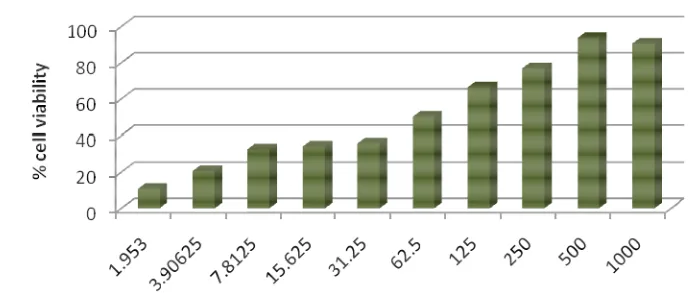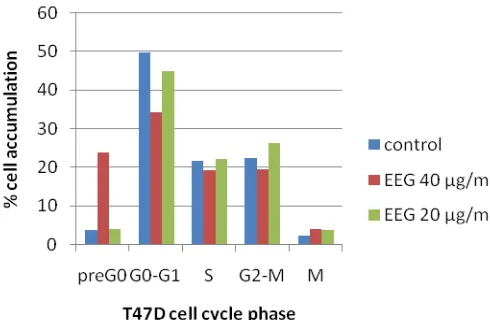Anticancer Effect and Cell Cycle Analysis of Ethanolic Extract of
Gembili
(
Dioscorea esculantaa
L. Burkill) on T47D Breast Cancer
Cell Line
Dina Fatmawati Soetoko,1* Sumarno
1
Faculty of Medicine, Islamic University of Sultan Agung
*Corresponding author, email: [email protected]
Abstract
Gembili (Dioscorea esculantae) has been known to contain saponin showing promise as potential candidate for anticancer therapy. Gembili extract has also shown cytotoxic activity against T47D breast cancer cell line. The present study aims to investigate the anti-proliferative effect of ethanolic extract of gembili against T47D breast cancer line. In this study, the T47D breast cancer cell line was divided into 3 groups including the control group and study groups (treated with the ethanolic extract of gembili at the dose of 40 g/mL and 20 g/mL). The anticancer activity was determined by cytotoxic test using MTT assay and distribution of each phases in cycle cell was tested against T47D breast cancer cell line by propidium iodine assay. Accumulation of cell in cycle cell were observed using flow cytometry. The study showed ethanolic extract of gembili has moderete cytotoxicity againts T47D breast cancer cell line and has a significant difference (p<0.05) in the number of cell accumulation in pre G0 between control and study groups. In conclusion, ethanolic extract of
gembili has concentration-dependent anticancer activitiy with significant alteration on cell cycle pattern. It has anticancer activities and anti-proliferative effect against T47D breast cancer cell line.
Key words: anticancer activity, cell cycle, gembili(Dioscorea esculantae L. Burkill), T47D breast cancer cell line.
INTRODUCTION
Cancer is a disease of malignant neoplasms that has a wide broad spectrum and complexity. Cancer progression is characterized by increased proliferative activity and the disruption of apoptosis. Based on data of the world's leading causes of death in 2005, cancer is the second highest cause of death after cardiovascular diseases. Until now almost no cancer can be cured by spontaneous treatment and if the cancer continues to be allowed to grow,
most death from cancer among women worldwide yearly. About 1.3 million new cases of invasive breast cancer are expected to occur. Breast cancer incidence has been rising in many developing countries. There have been improved patient survival and quality of life (Rasjidi, 2009).
8
distributed in Indonesia has been shown to contain saponin including diosgenin which is potential as anticancer. In previous study, the ethanolic extract of gembili
significantly shown antiinflamatory effect through suppresion of NF B (Olayemi and Ajaiyeoba, 2007 and Rizwana et al., 2007). However, the effect of ethanolic extract of
gembili as anticancer has not been
elucidated. In this study we demonstrated that ethanolic extract of gembili has anticancer activity against T47D breast cancer cell line by alterating cycle cell pattern.
MATERIAL AND METHODS Plant material
Gembili (D. esculanta L. Burkill) were collected from plantation located in Kendal, Central Java, Indonesia during March-May 2011. The Gembili (D.
esculanta L. Burkill) were identified by staff of develompent structure of plant, Department of biology, Semarang State University, Central Java, Indonesia. The fresh gembili (D. esculanta L. Burkill) were collected, chopped finely and air-dried at room temperature.
Preparation of Extract
Three hundred grams of dried and chopped materials were extracted with etanol by percolation method for 3 days, filtered and evaporated using rotary evaporator to produce ethanol extract of
gembili. The ethanol extracts were
dissolved in dimethyl sulfoxide (DMSO-Merck) and subsequently diluted to appropriate working concentrations with RPMI culture medium (RPMI-Sigma) for proliferation inhibitor proliferative.
Cell culture
The human breast cancer T47D cell line was obtained from the Parasitology
Laboratorium of Faculty of Medicine Gajah Mada University, Yogyakarta, Indonesia. The cells were grown and maintained in RPMI supplemented with 10% (v/v) foetal bovine serum (FBS-Sigma Aldrich), 0.5% fungizone (Gibco), 2% penstrep (Gibco), and incubated at 3o
C in a humidified atmosphere and 5% CO2 (Mooney et al., 2002; Tan et al., 2005).
Cytotoxic assay
Cytotoxicity of extract at various concentrations (1,562-1000 g/mL) was assesed using the 3-(4,5-dimethylthiazol-2-yl)-2.5-diphenyl tetrazolium bromide (MTT-Sigma) assay. The MTT colori-metric assay developed by Mosmann with modification was used to screen for cytotoxic activity of all the etanolic extracts of gembili. Briefly, the cells were seeded in 96-well plates at a density of 104 cells/well in 100 l culture medium. Following 24-h incubation, the cells were treated with different concentrations of etanolic extract of gembili and doxorubicin (positive control) for 24 h. The potential candidates which resulted in cell survival of less than 50% were further assessed for their IC50 (concentration that inhibits cell
growth by 50%) values at the con-centration range of 1000 and 1,562 g/ml. The concentration range used for doxo-rubicin was 100 to 1,562 g/mL. Each experiment was performed in triplicate. Then, washing and incubation was per-formed with MTT solution at 37°C for 4 h. The yellow MTT dye was reduced by succinic dehydrogenase in the mi-tochondria of viable cells to purple formazan crystals. The formazan crystals was diluted in 10% SDS HCl (0.1%). The result was measured using ELISA reader (595 nm) using a microplate reader (Varioscan Flash, Thermo, Finland) and presented in optical density (OD).
Figure 1. Effect of ethanolic extract of gembili on cell growth inhibition of T47D cell line. Cells at density of 1 x 104 cells/well were seeded in 96-well plates. Cell growth inhibition was determined by MTT assay. The data shown are the mean of three independent experiment, each with triplicate well.
The percentage of cytotoxicity compared to the untreated cells was expressed as cell viability (%) (see the equation on the previous page).
Data generated were used to plot a dose-response curve of which concen-tration of extract required to kill 50% of cell population (IC50) was determined
(CCRC, 2009).
Cell cycle distributrion of T47F cells
treated with ethanolic extract of gembili
using flowcytometry
The harvested cells (1 x 106) were seeded onto 6 microwell plates (Nunc®) and incubated for 24 h at 370C in 5% CO2.
Cells were treated using the sample at final concentration of ethanolic extract of
gembili 40 g/mL, 20 g/mL and
incu-bated for 24 h. Cells were harvested by trypsinization and collected in 15 ml tube, followed by centrifugation at 1200 rpm for 3 minute. The supernatant was discarded and 100 l of flow reagent was added, followed by incubation for 2 minute at room temperature. Subsequently, RNa-se solution was added at final concentration 1 mg/ml and Run FACS using Facs Calibur and Cell quest software (Becton and Dickinson).
Statistical analysis was performed using SPSS software, version 17. The IC50
values were calculated by probit analysis. All data shown as mean ± standart deviation. For differences between means, one-way analysis of variance (ANOVA) was used with posthoc analysis using either Tukey’s HSD test (for equal variances). Values of p< 0.05 were considered significant.
RESULTS AND DISCUSSION Cytotoxic assay
Cytotoxic assay was observed using MTT assay in T47D cell line exposed to 10 series concentration (1,562 g/mL to 1000 g/mL) of ethanolic extract of gembili for 24 h and percentage of cell viability was analyzed as shown in figure 1. The cell growth inhibition percentage of 1,953 g/mL was 10.76% and the increase of ethanolic extract of gembili concentration.
Figure 1 showed increased concen-trations of ethanolic extract of gembili
causing an increase in the percentage inhibition of cells growth. Cytotoxic assay showed that ethanolic extract of gembili
had a moderate cytotoxic activity against T47D cell line (IC50=39.61 g/mL).
10
Table 1. Average distribution of T47D cells in each cell cycle after treatment with ethanolic extract of gembili for 25 hours.
Treatment Number of cell (%) ± sd
preG0 G0-G1 S G2-M M
kontrol 3,81±3.03 * 49,75±2,29* 21,8±5,08 22,4±0,69* 2,53±0,81 EEG 40 µg/ml 23,95±10,83* 34,37±5,57* 19,26±3,22 19,57±1,09* 4,08±0,33 EEG 20 µg/ml 4,17±2,60* 45,1±2,15* 22,19±5,37 26,37±0,89* 3,89±0,36
Note : * indicated p value <0,05 using anova analysis with confidence interval 95%. The data shown are the mean ± deviation stamndard of triplicate. EEG was ethanolic extract of gembili.
Figure 2. Cell cycle phase distribution of T47D cells. T47D cells (1×106 cells/ml) treated with ethanolic extract of gembili (EEG) at various dose as well as RPMI were prepared for cell cycle analysis after 24 hours exposure. Cells stained with Propidium Iodide (PI) reagent were analysed with cell quest program using flow cytometer Becton and Dickinson). The data represent the mean of 3 independent experiments.
The IC50 value of doxorubicin on
T47D cell line was 9.96 g/mL and showed a strong cytotoxicity (IC50< 20
g/mL). The previ-ous findings showed that diosgenin in gembili had anticancer activity on breast cancer cell lines through antiproliferative activity and induction apoptosis (Riswana et al., 2010 and Podolak et al., 2010). In addition, Olayemi and Ajaiyeoba (2007) and Carnago et al. (2011) found an antiinflammatory and antioxidant effect of ethanolic extract of
gembili in mice and in vitro respectively.
Cell cycle distribution
The ethanolic extract of gembili
inhibited cell proliferation at various concentrations in dose dependent manner. In addition, the mechanism behind the anticancer activity of ethanolic extract of
gembili on cell cycle phases of T47D were investigated. The T47D cell lines were treated with extract at different concentrations of 20 g/mL, 40 g/mL for 24 h and percentage of cell distribution in each phase of cell cycle was shown in table 1.
Table 1 showed the number of accumulated T47D cells in each cell cycle after treatment with ethanolic extract of
gembili for 24 hours. Treatment with 40 µg/ml of ethanolic extract of gembili
Cell cycle modulation by various natural and synthetic agents is gaining widespread attention in recent years. Given that disruption of cell cycle plays a crucial role in cancer progression, its modulation by phytochemicals seems to be a logical approach in controlling carcino-genesis (Singh et al., 2002). T47D cell cycle modulation was indicated by accumulation of cells in pre G0 phase 6.2 fold higher compared to control (3.80% to 23.95%). Pozarowski (2004) mentions that the cells undergoing apoptosis often have fractional DNA due to DNA fragmen-tation. In the sub-G0 phase is only a fraction of DNA in the cell apotosis-looking.
These result suggests that ethanolic extract of gembili has antiproliferative effect indicated by acummulation of percentage cell distribution in pre G0 (Figure 2). The higher number of cells accumulated in pre G0 phase was probably due to most of cells have undergone apoptosis but the mechanism need to be explored further in more details.
CONCLUSION
Ethanolic extract of gembili have concentration dependent anticancer activities with significant alteration on cell cycle pattern in comparison to control.
ACKNOWLEDGEMENT
We would like to thanks National Institute of Health and Research Develop-ment. The Indonesian Ministry of Health for funding this research.
REFERENCES
Cancer chemoprevention research. 2009.
Prosedur Uji Sitotoksisitas. Fakultas Farmasi Universitas Gadjah Mada. Yogyakarta
Cornago D E., Rumbaoa R W., Geronimo
I.M., 2011. Philiphine Yams
(Dioscorea spp) Tubers Phenolic content and Antioxidant Capacity.
Meiyanto E, Aditya F, Hermawan A, Junedi S, Susidarti RA., 2011. The Improvement of Doxorubicin Activity on Breast Cancer Cell Lines by
Tangerti Through Cell Cycle
Modulation. Orient Pharm Exp Med
(2011) 11;183-190 2007.Anti-inflammatory studies of yam (Dioscorea esculenta) extract on wistar rats. African Journal of Biotechnology. Vol. 6 (16), pp. 1913-1915, 20 August 2007
Podolak I, Galanty A, Sobolewska D., 2010. Saponins as Cytotoxic Agents: a review. Phytho Rev (2010) 9:425-474. DOI 10.1007/s11101-010-9183-z Pozarowski P, Grabarek J, Darzynkiewicz
Z. Flow Cytometry of Apoptosis. Curr protoc cell biol. 2004. chapter 18; unit 18.8.
Rasjidi I., 2009. Deteksi Dini dan
Pence-gahan Kanker Pada Wanita. Sagung
Seto. Jakarta
Rizwana et al., 2010. A survey on phytochemical and bioactivity of plant extracts from Malaysian forest reserves. Journal of Medicinal Plants Research Vol. 4(3), pp. 203-210, 4 February 2010.
Singh RP, Dhanalakshmi S, Agarwal R., 2002. Phytochemicals as Cell Cycle Modulators. Cell Cycle. 1(3): 156-161. Tan ML, Sulaiman SF, Najimuddin N, Samian MR, Muhammad TST (2005). Methanolic extract of Pereskia bloe (Kunth) DC. (Cactaceae) induces apoptosis in breast carcinoma, T47D cell line. J. Ethnopharmacol. 96:287-294.

